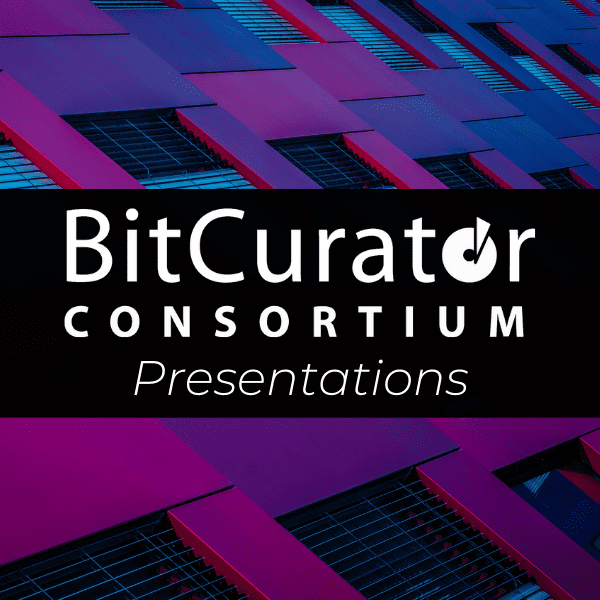Panel: Workflows and Collaboration
Kevin Glick, Cate Peebles, Bob Rice, Brianna Losardo, David Cirella, Kelsey O'Connel, Alice Prael | BitCurator Consortium
Gaining control of our legacy media backlog: appraisal of previously unmanaged born-digital material
In this talk I will provide a case study of a project undertaken at Seton Hall University to address the backlog of legacy media containing the working and office files of the Archives & Special Collections department. The primary goal of the project was to identify and preserve information about accessions and processing of the university’s archival collections, and to dispose of information with no enduring value securely and with confidence that no important information was being lost.
This process involved systematic disk imaging, appraisal, preservation, and in some cases documented destruction of born-digital material. As a result, we gained better control of our digital materials, identified content for long-term preservation, removed unnecessary material, and created procedures which can be applied to the records of other University departments and collections moving forward.
- Brianna LoSardo, Seton Hall University
How Much is Enough? Determining Levels of Digital Forensics
For the past decade or so, cultural heritage institutions have increasingly adopted digital forensics practices into their workflows. Various publications, case studies, and reports have corroborated the place and value of digital forensics in the archival field as it supports the validation and preservation of born-digital files as authentic artifacts.
Simultaneously, a growing trend in favor of MPLP processing techniques promotes processing collection material as efficiently as possible to promote access to materials. Yet with seemingly endless digital forensics programs and practices to choose from, the application of various digital forensics processes can slow down processing. Once an institution has committed itself to the adoption of digital forensics in their workflows, how much digital forensics is enough and how much is too much?
This presentation will propose a tiered framework for determining which digital forensics applications to apply in different scenarios, helping to categorize and document when it is appropriate to conduct minimal digital forensics versus more thorough examinations. Drawing on trial and error testing, it will include examples of how too little and too much digital forensics impacts different scenarios. Arguing that standardizing digital forensics analyses across all collections slows down processing efforts, this presentation hopes to spark a conversation with digital forensics practitioners about best practices of using digital forensics programs in our workflows.
Ultimately, the presenter seeks to begin answering the question: how do we ensure the integrity of our digital objects using digital forensics while simultaneously meeting the demands of the MPLP philosophy?
- Kelsey O’Connell, Northwestern University
How to Frost a Cake: Sweetening the Task of Digital Preservation through Layers of Collaboration
A program of digital preservation must be both a wide and deep-reaching service that enables collaboration between layers of stakeholders, each with domain-specific knowledge and areas of specialization. While the primary issues addressed by digital preservation, suggest purely technical solutions, cross-departmental and intra-institutional collaboration between stakeholders is a first class requirement.
Towards these ends, the Digital Preservation Unit provides user support and management of our digital preservation system, working in direct collaboration with, and often, as a layer between our various users and partners from across the University. Stakeholders in the system include those responsible for collections, including Archivists, Librarians, and Curators from the institution’s Libraries, Museums, and Galleries, and those who provide support including our primary systems administrators and developers in Library IT, infrastructure engineers in Central IT, and the vendors of our preservation system software and other services including cloud storage and communications infrastructure. Providing a robust, effective, and widely used digital preservation system requires support for all stakeholders in a manner that abstracts the overall complexity and lowers barriers to fulfilling each repository’s use cases.
The session will explore the Yale Digital Preservation service through the experiences of users from the Libraries, Museums, and systems administrators, while exploring the practices and tools used to support each area’s needs. The purpose of this panel is to illuminate and discuss the implementation of collaborative practices that promote Yale repositories’ shared goal of preserving culturally significant digital collections.
- David Cirella, Cate Peebles, Alice Prael, Bob Rice, Kevin Glick, Yale University Libraries

Kevin Glick, Cate Peebles, Bob Rice, Brianna Losardo, David Cirella, Kelsey O'Connel, Alice Prael. (October 25, 2019). Panel: Workflows and Collaboration. BitCurator Consortium.